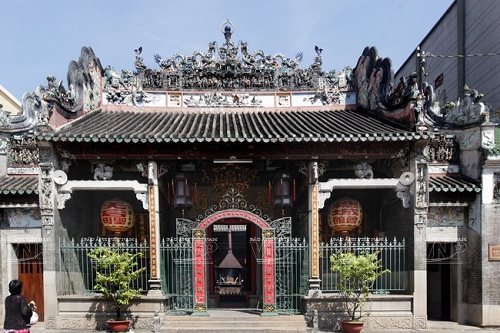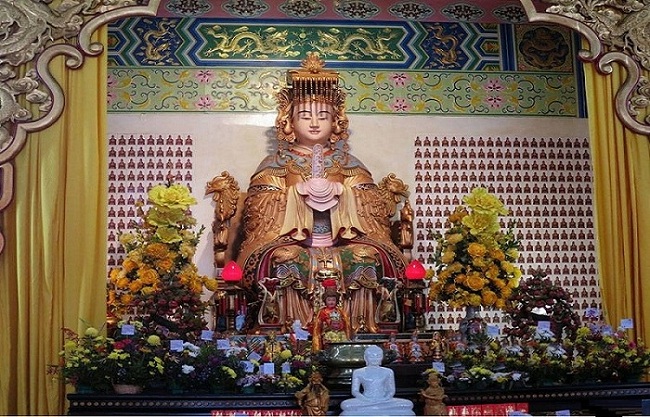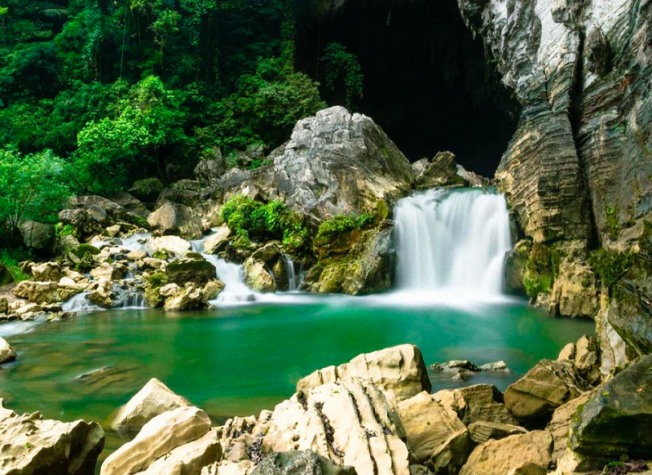Thien Hau Pagoda Saigon: the Best Temple in Ho Chi Minh City
History of Thien Hau Temple (Thien Hau Pagoda):
Thien Hau Pagoda (Vietnamese: Chùa Bà Thiên Hậu) means "Empress of Heaven Pagoda", is for an epithet of the Chinese Goddess of the Sea, the deified form of Lin Moniang, a medieval girl of Fujianese who saving one or some of her family members from harm during a typhoon with her spiritual power.

Although this was unrecognized by both the governments of China Mainland and Taiwan, the faith is very popular in the maritime southern provinces of China and on Taiwan and among the Chinese diaspora. In Vietnam, she is also usually known as the "Lady of the Sea". Mazuism is frequently syncretized with Buddhism and Taoism. For example, at the Quan Am Pagoda (Lady Buddha Pagoda) nearby, the two main altars are dedicated to worship Thien Hau (Empress of Heaven) and Quan Am (Lady Buddha).

The temple was first built in 1760 by the Cantonese community in the city. It saw major repairs for the expansions in the years of 1800, 1842, 1847, 1882, 1890, and 1916.
Architecture of Thien Hau Temple (Thien Hau Pagoda):
- Exterior of Pagoda:
The temple is located right on busy Street of Nguyen Trai. Visitors can accesse by entering through an iron gate, or crossing a small courtyard. The roof of Thien Hau Temple is decorated with small delicately fashioned porcelain figurines expressing themes from religion and legends of Chinese. The entrance of Pagoda is decorated with lanterns and wooden models of Chinese theaters.
- Interior of Pagoda:
The interior of the Thien Hau Pagoda is actually a partially covered courtyard with the altar to Mazu at the end. The exposed portions of the Pagoda’s courtyard contain incense burners, and open the view to the remarkable porcelain decorate the roof. The dioramas of Pagoda show scenes from a 19th-century Chinese city, and include very colorful figures as actors, demons, animals, and sailors and traders of Persian and European.
In one scene, actors depict a duel on horseback battle between Chinese general Guan Yu of the novel Three Kingdoms Period and another fighter. Another scene depicts the three Taoist Gods, that representing longevity, fecundity and prosperity.
The altar worshing to Mazu is dominated by the three statues of the goddess. The faces of Goddess are bronze in color, and the clothes with crowns are painted with multi-colored.
Best Time to Visit and How to Get to Thien Hau Pagoda in HCMC?
Thien Hau Pagoda is one of the most famous pagoda in Ho Chi Minh City, that is always busy with locals and foreign tourists daily. So the Best Time to visit Thien Hau Pagoda is in the early morning to avoid the crowd and enjoy the peaceful and tranquil atmosphere here.
Thien Hau Pagoda is located in the center of Ho Chi Minh City so it is very easy for you to get there. It really depend on location of your accommodations, conditions, hobbies, etc. You can choose any means of transportation suitable for you, like motorbike taxi (Xe Ôm), public bus, taxi or walking. If you love to discover a diversified culture, Thien Hau Pagoda will be an ideal place in your itinerary.
See Also:

![]()
![]()
![]()
![]()
![]()
Best of Vietnam

Best Vietnamese Food You Have to Try in Vietnam
Best Food in Vietnam: Vietnamese Traditional Food is top World well known to be both healthy and...

10 Best National Parks in Vietnam
Vietnam Travel Guide: If you look for the Best Wildlife Discovery Experience in Vietnam, here are...
Read More
Best Souvenir to Buy in Vietnam
If you look for Best Things to Buy when traveling to Vietnam to bring home for your family & friends...
Read More
The 10 Best Places to Visit in Vietnam
Vietnam Travel Guide: Home to an extensive collection of historical and cultural attractions,...
Read More
Top 10 Museums You Should Not Miss in Vietnam
Vietnam, 4.000 years old country has a unique and lengthy history, culture with 54 ethnic groups. It...
Read MoreFind your trip
Vietnam Best Tours
Vietnam Car Rental
Vietnam Travel Blog
- Vietnamese People: Origin, History, Culture and Traditions
- Vietnam Currency: Best ATM and Places to Exchange Money
- Vietnam Map: Regions, Cities & Provinces Map of Vietnam
- What is illegal Things in Vietnam: Rules & Laws for Tourists
- Best Time to Travel to Vietnam to Avoid the Bad Weather
- Vietnam News: Population & Religions of 54 Ethnic Groups









